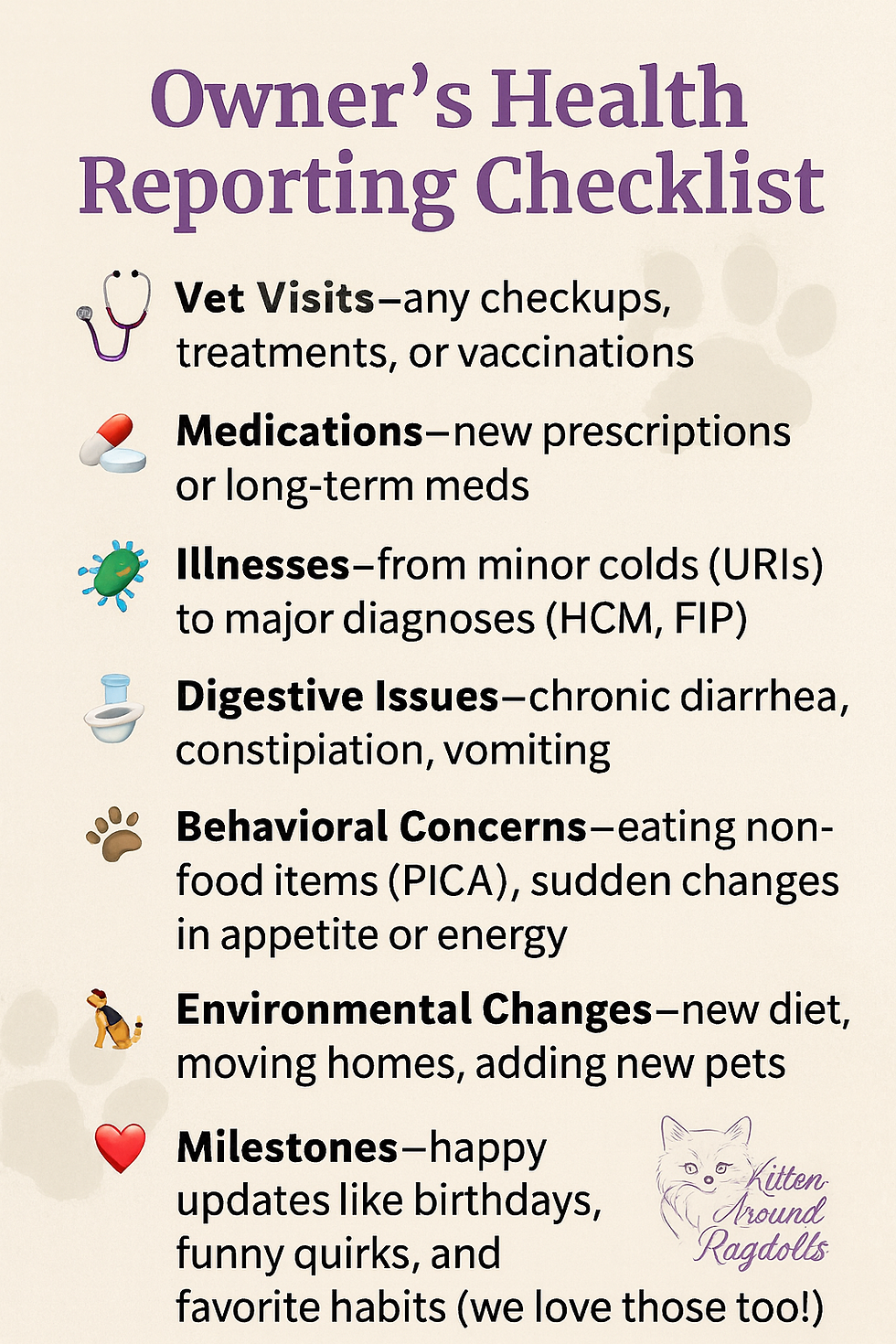Why Is My Cat Throwing Up?
- Kitten Around
- Jul 23
- 4 min read
Updated: Jul 25
A Guide for Concerned Cat Parents
Vomiting in cats can be alarming — and messy! Whether it's a one-time incident or a recurring problem, understanding the why behind your cat’s throw-up can help you respond quickly and appropriately.
If you keep asking yourself: Why does my cat keep throwing up? Why is my cat puking?
If you're wondering why your cat keeps throwing up, this article is for you.
In this post, we’ll walk you through the common causes, when to worry, and what different types and colors of cat vomit might mean. Plus, we’ll include helpful images so you can compare what you’re seeing at home.
🐱 Why is my Cat Throwing Up?
Is It Normal for Cats to Throw Up?
Occasional hairballs or stomach upset can be perfectly normal, especially in long-haired breeds like Ragdolls. But if your cat vomits frequently, seems lethargic, loses weight, or stops eating — it’s time to dig deeper.

🧪 Common Reasons Cats Throw Up
1. Hairballs
Cats groom themselves constantly, and sometimes that fur builds up in the stomach. Hairballs are often coughed up with a gagging sound and may look like a slimy, sausage-shaped wad of fur.
2. Eating Too Fast
Some cats scarf their food, which leads to regurgitation — undigested food usually comes up within 15–30 minutes of eating.
3. Dietary Intolerance or Food Allergy
Switching foods too fast, or feeding ingredients your cat can’t tolerate, can cause vomiting. Common culprits include dairy, certain proteins, or artificial additives.
4. Ingesting Foreign Objects
Rubber bands, string, plastic, or even houseplants can trigger vomiting. If you suspect your cat swallowed something they shouldn’t have — call your vet immediately.
5. Parasites, Infections, or Underlying Illness
Vomiting can be a symptom of:
Intestinal parasites
Bacterial or viral infections
Kidney or liver disease
Hyperthyroidism
Diabetes
Cancer
A vet visit is crucial if vomiting is accompanied by lethargy, weight loss, diarrhea, or behavior changes.
🎨 What Does the Color of Vomit Mean?

Understanding the color and texture of your cat’s vomit can give clues to what’s going on. Here's a handy visual guide:
Vomit Color | Possible Cause |
🟤 Brown | Hairball, digested food, internal bleeding |
🟡 Yellow/Green | Bile from an empty stomach |
🔴 Red (or pink) | Blood in vomit, possible emergency |
⚫ Black/Tarry | Internal bleeding or toxins |
🟠 Orange/Light Brown | Undigested food, fast eating |
⚪ White Foam | Empty stomach, stress, reflux |
According to the UC Davis School of Veterinary Medicine, blood in vomit or stool is a medical emergency. The content of the vomit also matters (e.g., foreign objects).
Dr. Lori Teller, associate professor at Texas A&M College of Veterinary Medicine says, “Almost all cats will vomit on occasion, so it’s pretty common. If a cat vomits now and then and is otherwise healthy—with a normal appetite, water consumption, activity level, and bowel movements—then generally we are not too worried about it."
🚨 When to Call the Vet
Call your vet if your cat:
Vomits more than 1–2x a week
Has blood in their vomit
Shows signs of pain or distress
Isn’t eating or drinking
Seems lethargic or weak
Has concurrent diarrhea or constipation
📌 Tip for Pet Parents:
If you're unsure which one you're seeing, record a video to show your vet. It helps immensely in diagnosing the cause.
🏠 At-Home Care Tips
Switch foods gradually over 7–10 days
Use slow-feeder bowls to prevent scarfing
Regular grooming to reduce hairball formation
Keep toxic plants and string-like items out of reach
Add fiber or hairball control treats to your routine
When Vomiting Is Not Vomiting
Cats sometimes cough, regurgitate, or have hairball episodes that look like vomiting but aren’t. Clarifying the differences helps educate your readers:
Coughing = hacking without expelling food
Regurgitation = passive, often right after eating
Vomiting = active, heaving motion with abdominal effort
🤔 Is It Vomiting, Regurgitation, or Coughing?
Behavior | Description | Timing | Effort Level | Common Causes | What It Looks Like |
Vomiting | Forceful expulsion of stomach contents via the mouth | After eating or anytime | Active (heaving, retching) | Hairballs, food intolerance, illness | Chunky food, bile, foam, or hairball |
Regurgitation | Passive return of undigested food from the esophagus | Right after eating | Passive (no retching) | Eating too fast, esophageal issues | Whole kibble or sausage-like food pile |
Coughing | Sharp expulsion of air from the lungs | Random | Moderate (hacking sound) | Asthma, respiratory infections, inhaled irritants | Dry hacking, sometimes mistaken for gagging |
❤️ Final Thoughts
Occasional vomiting isn’t always a cause for panic, but chronic or severe vomiting is your cat’s way of saying something’s wrong. Trust your instincts, keep an eye on the details, and when in doubt — call your vet.
If you're a Ragdoll owner and unsure what’s normal for your kitten, feel free to reach out to us here at Kitten Around Ragdolls. We're happy to offer advice or connect you with a trusted vet.
If you have comments or questions, please share them below.
.png)







